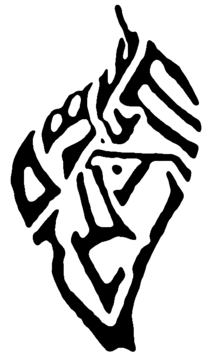Samaritanism
The Samaritan religion, also known as Samaritanism, is the national religion[1] of the Samaritans.[2][3][4][5][6][7][8][9] The Samaritans adhere to the Samaritan Torah, which they believe is the original, unchanged Torah,[10] as opposed to the Torah used by Jews. In addition to the Samaritan Torah, Samaritans also revere their version of the Book of Joshua and recognize some Biblical figures, such as Eli.
| Samaritanism | |
|---|---|
| הדת השומרונית السامرية | |
Samaritan mezzuzah | |
| Type | Abrahamic |
| Scripture | Samaritan Torah |
| Separated from | Judaism |
| Members | Samaritans |
| Part of a series on |
| Samaritanism |
|---|
 |
| Samaritan saints |
| Related religious groups |
| Practices |
| Scriptures and writings |
|
Samaritanism is internally described as the religion that began with Moses, unchanged over the millennia that have since passed. Samaritans believe Judaism and the Jewish Torah have been corrupted by time and no longer serve the duties God mandated on Mount Sinai. Jews view the Temple Mount as the most sacred location in their faith, but Samaritans regard Mount Gerizim as their holiest site.
History
Samaritanism holds that the summit of Mount Gerizim is the true location of God's Holy Place, as opposed to the Foundation Stone on the Temple Mount as Judaism teaches. As such, Samaritans trace their history as a separate entity from the Jews back to the time of Moses, where they believe Joshua laid the foundation for their temple. Samaritan historiography traces the schism itself to the High Priest Eli abandoning Moses' Tabernacle in favor of Mount Gerizim following Joshua's death.
Abu l-Fath, who in the 14th century wrote a major work of Samaritan history, comments on Samaritan origins as follows:[11]
A terrible civil war broke out between Eli son of Yafni, of the line of Ithamar, and the sons of Pincus (Phinehas), because Eli son of Yafni resolved to usurp the High Priesthood from the descendants of Pincus. He used to offer sacrifices on an altar of stones. He was 50 years old, endowed with wealth and in charge of the treasury of the Children of Israel. ...
He offered a sacrifice on the altar, but without salt, as if he were inattentive. When the Great High Priest Ozzi learned of this, and found the sacrifice was not accepted, he thoroughly disowned him; and it is (even) said that he rebuked him.
Thereupon he and the group that sympathized with him, rose in revolt and at once he and his followers and his beasts set off for Shiloh. Thus Israel split in factions. He sent to their leaders saying to them, Anyone who would like to see wonderful things, let him come to me. Then he assembled a large group around him in Shiloh, and built a Temple for himself there; he constructed a place like the Temple (on Mount Gerizim). He built an altar, omitting no detail—it all corresponded to the original, piece by piece.
At this time the Children of Israel split into three factions. A loyal faction on Mount Gerizim; a heretical faction that followed false gods; and the faction that followed Eli son of Yafni in Shiloh.
Further, the Samaritan Chronicle Adler, or New Chronicle, believed to have been composed in the 18th century using earlier chronicles as sources, states:
And the Children of Israel in his days divided into three groups. One did according to the abominations of the Gentiles and served other gods; another followed Eli the son of Yafni, although many of them turned away from him after he had revealed his intentions; and a third remained with the High Priest Uzzi ben Bukki, the chosen place.
Samaritanism emerged as an independent ethnic culture following its survival of the Assyrian captivity in the 8th century BC. The traditional Jewish narrative of 2 Kings[12] and Josephus,[13] has it that the people of Israel were removed by the king of the Assyrians (Sargon II)[14] to Halah, to Gozan on the Khabur River and to the towns of the Medes. The king of the Assyrians, we are then told, then brought people from Babylon, Kutha, Avah, Emath, and Sepharvaim to settle in Samaria. Because God sent lions among them to kill them, the king of the Assyrians sent one of the priests from Bethel to teach the new settlers about God's ordinances. The eventual result was that the new settlers worshiped both the God of the land and their own gods from the countries from which they came.
Modern genetic studies (2004) suggest that Samaritans' lineages trace back to a common ancestor with Jews in the paternally-inherited Jewish high priesthood (Cohanim) temporally proximate to the period of the Assyrian conquest of the kingdom of Israel, and are probably descendants of the historical Israelite population,[15][16] albeit isolated given the people's reclusive history. This casts doubt into, if not totally disproves, this historical theory that Samaritans originated from Assyria.
Furthermore, the Dead Sea scroll 4Q372, which recounts the hope that the northern tribes will return to the land of Joseph, remarks that the current dwellers in the north are fools, an enemy people, but does not explicitly refer to them as foreigners. It goes on to say that these people, the Samaritans, mocked Jerusalem and built a temple on a high place (Gerizim) to provoke Israel.[17]
Conflicts between the Samaritans and the Jews were numerous between the end of the Assyrian diaspora and the Bar Kokhba revolt. The Tanakh describes multiple instigations from the Samaritan population against the Jews and disparages them, and Jesus' Parable of the Good Samaritan also gives evidence of conflict.[18] The destruction of Mount Gerizim's Samaritan temple is attributed to the High Priest John Hyrcanus.
Following the failed revolts, Mount Gerizim was rededicated with a new temple, which was ultimately again destroyed during the Samaritan Revolts. Persecution of Samaritans was common in the following centuries.
Beliefs
The principle beliefs of Samaritanism are as follows:[19][20][21]
- There is one God, Yahweh, the same God recognized by the Hebrew prophets. Faith is in the unity of the Creator which is absolute unity. It is the cause of the causes, and it fills the entire world. His nature can not be understood by human beings, but according to his actions and according to his revelation to his people and the kindness he showed them.
- The Torah is the only true holy book, and was given by God to Moses. The Torah was created before the creation of the world and whoever believes in it is assured a part in the World to Come. The status of the Torah in Samaritanism as the only holy book causes Samaritans to reject the Oral Torah, Talmud, and all prophets and scriptures except for Joshua, whose book in the Samaritan community is significantly different from the Book of Joshua in the Tanakh/Old Testament. Essentially, the authority of all post-Torah sections of the Tanakh, and classical Jewish Rabbinical works (the Talmud, comprising the Mishnah and the Gemara) is rejected. Moses is considered to be the last of the line of prophets.
- Mount Gerizim, not Jerusalem, is the one true sanctuary chosen by Israel's God. The Samaritans do not recognize the sanctity of Jerusalem and do not recognize Mount Moriah.
- The apocalypse, called "the day of vengeance". At the end of days, in which a figure called the Taheb (essentially the Samaritan equivalent of the Jewish Messiah) from the tribe of Joseph, be it Ephraim or Manessah, who will be a prophet like Moses (though some say he will be Moses) for forty years, and bring about the return of all the Israelites, following which the dead will be resurrected. The Taheb will then discover the tent of Moses' Tabernacle on Mount Gerizim, and will be buried next to Joseph when he dies.
Festivals and observances
The Samaritan preserve the proto-Hebraic script, conserve the institution of a High Priesthood, and the practice of slaughtering and eating lambs on Passover eve. They celebrate Pesach, Shavuot, Sukkot [22] but use a different mode from that employed in Judaism in order to determine the dates annually.[23]Yom Teru'ah (the Biblical name for "Rosh Hashanah"), at the beginning of Tishrei, is not considered a New Year as it is in Rabbinic Judaism.
Passover is particularly important in the Samaritan community, climaxing with the sacrifice of up to 40 sheep. The Counting of the Omer remains largely unchanged; however, the week before Shavuot is a unique festival celebrating the continued commitment Samaritanism has maintained since the time of Moses. Shavuot is characterized by nearly day-long services of continuous prayer, especially over the stones on Gerizim traditionally attributed to Joshua.
During Sukkot, the sukkah is built inside houses, as opposed to outdoor settings that are traditional among Jews.[24] Samaritan historian Benyamim Tsedaka traces the indoor-sukkah tradition to persecution of Samaritans during the Byzantine Empire.[24] The roof of the Samaritan sukkah is decorated with citrus fruits and the branches of palm, myrtle, and willow trees, according to the Samaritan interpretation of the four species designated in the Torah for the holiday.[24]
The restrictions of Yom Kippur are more universal in Samaritanism, with even breastfeeding and the feeding of children being disallowed.
 Samaritans, from a photo c. 1900 by the Palestine Exploration Fund.
Samaritans, from a photo c. 1900 by the Palestine Exploration Fund. Sukkot on Mount Gerizim
Sukkot on Mount Gerizim Entrance to a modern Samaritan synagogue in the city of Holon, Israel
Entrance to a modern Samaritan synagogue in the city of Holon, Israel
Religious texts

Samaritan law differs from Halakha (Rabbinic Jewish law) and other Jewish movements. The Samaritans have several groups of religious texts, which correspond to Jewish Halakha. A few examples of such texts are:

- Samaritan Pentateuch: There are some 6,000 differences between the Samaritan Pentateuch and the Masoretic Jewish Pentateuch text; and, according to one estimate, 1,900 points of agreement between it and the Greek LXX version. Several passages in the New Testament would also appear to echo a Torah textual tradition not dissimilar to that conserved in the Samaritan text. There are several theories regarding the similarities. The variations, some corroborated by readings in the Old Latin, Syriac and Ethiopian translations, attest to the antiquity of the Samaritan text,[25][26][27] although the exact date of composition is still largely unclear. Granted special attention is the so-called "Abisha Scroll", a manuscript of the Pentateuch tradition attributed to Abishua, grandson of Aaron, traditionally compiled during the Bronze Age. However, testing on the scroll revealed it was created no earlier than the 14th century CE, in fact around a century younger than the world's oldest Torah scroll.
- Historical writings
- Samaritan Chronicle, The Tolidah (Creation to the time of Abishah)
- Samaritan Chronicle, The Chronicle of Joshua (Israel during the time of divine favor) (4th century, in Arabic and Aramaic)
- Samaritan Chronicle, Adler (Israel from the time of divine disfavor until the exile)
- Hagiographical texts
- Samaritan Halakhic Text, The Hillukh (Code of Halakha, marriage, circumcision, etc.)
- Samaritan Halakhic Text, the Kitab at-Tabbah (Halakha and interpretation of some verses and chapters from the Torah, written by Abu Al Hassan 12th century CE)
- Samaritan Halakhic Text, the Kitab al-Kafi (Book of Halakha, written by Yosef Al Ascar 14th century CE)
- Al-Asatir—legendary Aramaic texts from the 11th and 12th centuries, containing:
- Haggadic Midrash, Abu'l Hasan al-Suri
- Haggadic Midrash, Memar Markah—3rd or 4th century theological treatises attributed to Hakkam Markha
- Haggadic Midrash, Pinkhas on the Taheb
- Haggadic Midrash, Molad Maseh (On the birth of Moses)
- Defter, prayer book of psalms and hymns.[28]
- Samaritan Haggadah[29]
See also
References
- Shulamit Sela, The Head of the Rabbanite, Karaite and Samaritan Jews: On the History of a Title, Bulletin of the School of Oriental and African Studies, University of London, Vol. 57, No. 2 (1994), pp. 255–267
- David Noel Freedman, The Anchor Bible Dictionary, 5:941 (New York: Doubleday, 1996, c1992).
- David Noel Freedman, The Anchor Bible Dictionary, 5:941 (New York: Doubleday, 1996, c1992).
- Reinhard Pummer (2002). Early Christian Authors on Samaritans and Samaritanism: Texts, Translations and Commentary. Mohr Siebeck. pp. 123, 42, 156. ISBN 978-3-16-147831-4.
- R. J. Coggins (1975). Samaritans and Jews: the origins of Samaritanism reconsidered. Westminster John Knox Press. ISBN 978-0-8042-0109-4.
- Saint Epiphanius (Bishop of Constantia in Cyprus) (1 January 1987). The Panarion of Ephiphanius of Salamis: Book I (sects 1–46). BRILL. p. 30. ISBN 978-90-04-07926-7.
- Paul Keseling (1921). Die chronik des Eusebius in der syrischen ueberlieferung (auszug). Druck von A. Mecke. p. 184.
- Origen (1896). The Commentary of Origen on S. John's Gospel: The Text Rev. with a Critical Introd. & Indices. The University Press.
- Grunbaum, M.; Geiger, Rapoport (1862). "mitgetheilten ausfsatze uber die samaritaner". Zeitschrift der Deutschen Morgenländischen Gesellschaft: ZDMG. 16. Harrassowitz. pp. 389–416.
- Tsedaka, Benyamim (2013-04-26). The Israelite Samaritan Version of the Torah. ISBN 9780802865199. Retrieved 18 March 2015.
- The Keepers, An Introduction to the History and Culture of the Samaritans, by Robert T. Anderson and Terry Giles, Hendrickson Publishing, 2002, pages 11–12
- 2 Kings 17.
- Josephus, Antiquities 9.277–91
- See the wording of 2 Kings 17, which mentions Shalmaneser in verse 3 but the "king of the Assyrians" from verse 4 onward.
- Shen, P; Lavi, T; Kivisild, T; Chou, V; Sengun, D; Gefel, D; Shpirer, I; Woolf, E; Hillel, J (2004). "Reconstruction of patrilineages and matrilineages of Samaritans and other Israeli populations from Y-chromosome and mitochondrial DNA sequence variation" (PDF). Human Mutation. 24 (3): 248–60. doi:10.1002/humu.20077. PMID 15300852.
- Kiaris, Hippokratis (2012). Genes, Polymorphisms and the Making of Societies: How Genetic Behavioral Traits Influence Human Cultures. Universal Publishers (published April 1, 2012). p. 21. ISBN 978-1612330938.
- Magnar Kartveit (2009). The Origin of the Samaritans. BRILL. pp. 168–171. ISBN 9004178198. Retrieved 30 January 2014.
- John 4:9, namely, "For Jews do not associate with Samaritans."
- "Religion of the Israelite Samaritans : The Root of all Abrahamic Religions".
- "Religion of the Israelite Samaritans".
- "Samaritan - Encyclopedia.com". www.encyclopedia.com.
- Anne Katrine de Hemmer Gudme, Before the God in this Place for Good Remembrance: A Comparative Analysis of the Aramaic Votive Inscriptions from Mount Gerizim, Walter de Gruyter, 2013 ISBN 978-3-110-301878- p.52
- Sylvia Powels, ‘The Samaritan Calendar and the Roots of Samaritan Chronology,' in A.D. Crown (ed.) The Samaritans, Mohr Siebeck, 1989 ISBN 978-3-161-45237-6 pp.691-741.
- Lieber, Dov; Luzi, Iacopo. "Inside the Samaritan high priest's fruity sukkah, literally". www.timesofisrael.com. Retrieved 2019-12-05.
- James VanderKam, Peter Flint, The Meaning of the Dead Sea Scrolls: Their Significance For Understanding the Bible, Judaism, Jesus, and Christianity, A&C Black, 2nd ed. 2005 p.95.
- Timothy Michael Law, When God Spoke Greek: The Septuagint and the Making of the Christian Bible, Oxford University Press, USA, 2013 p.24.
- Isac Leo Seeligmann, The Septuagint Version of Isaiah and Cognate Studies,. Mohr Siebeck 2004 pp.64ff.
- Samaritan Documents, Relating To Their History, Religion and Life, translated and edited by John Bowman, Pittsburgh Original Texts & Translations Series Number 2, 1977.
- זבח קרבן הפסח : הגדה של פסח, נוסח שומרוני (Samaritan Haggada & Pessah Passover / Zevaḥ ḳorban ha-Pesaḥ : Hagadah shel Pesaḥ, nusaḥ Shomroni = Samaritan Haggada & Pessah Passover), Avraham Nur Tsedaḳah, Tel Aviv, 1958
Further reading
- Montgomery, James Alan (2006) [1907]. The Samaritans, the Earliest Jewish Sect. The Bohlen Lectures for 1906. Eugene, Oregon: Wipf & Stock. ISBN 1-59752-965-6.
- Thomson, J. E. H. (1919). Tha Samaritans: Their Testimony to the Religion of Israel. Edinburgh & London: Oliver and Boyd.
- Gaster, Moses (1925). The Samaritans: Their History, Doctrines and Literature. The Schweich Lectures for 1923. Oxford University Press.
- Macdonald, John (1964). The Theology of the Samaritans. New Testament Library. London: SCM Press.
- Bourgel Jonathan , "Brethren or Strangers Samaritans in the Eyes of Second Century ʙ ᴄ ᴇ Jews", Biblica 98/3 (2017), pp. 382–408; https://www.academia.edu/35217703/Bourgel_Brethren_or_Strangers_Samaritans_in_the_Eyes_of_Second_Century_%CA%99_%E1%B4%84_%E1%B4%87_Jews_Biblica
- Purvis, James D. (1968). The Samaritan Pentateuch and the Origin of the Samaritan Sect. Harvard Semitic Monographs. 2. Cambridge, Massachusetts: Harvard University Press.
- Bowman, John (1975). The Samaritan Problem. Pickwick Press.
- Coggins, R. J. (1975). Samaritans and Jews: The Origins of Samaritanism Reconsidered. Growing Points in Theology. Oxford: Basil Blackwell.
- Pummer, Reinhard (1987). The Samaritans. Leiden: E. J. Brill. ISBN 90-04-07891-6.
- Hjelm, Ingrid (2000). Samaritans and Early Judaism: A Literary Analysis. Journal for the Study of the Old Testament. Supplement Series, 303. Sheffield Academic Press. ISBN 1-84127-072-5.
- Hjelm, Ingrid, "Mt Gerezim and Samaritans in Recent Research", in Samaritans: Past and Present: Current Studies, Edited by Mor, Menachem; Reiterer, Friedrich V.; Winkler, Waltraud (Berlin, New York) (DE GRUYTER) 2010, Pages 25–44, eBook ISBN 978-3-11-021283-9, Print ISBN 978-3-11-019497-5
- Anderson, Robert T.; Giles, Terry (2002) [2002]. The Keepers: An Introduction to the History and Culture of the Samaritans. Hendrickson Publishing. ISBN 1-56563-519-1.
- Anderson, Robert T., Giles, Terry, "Tradition kept: the literature of the Samaritans"(Hendrickson Publishers, 2005)
- Crown, Alan David (2005) [1984]. A Bibliography of the Samaritans: Revised Expanded and Annotated (3rd ed.). Scarecrow Press. ISBN 0-8108-5659-X.
- Heinsdorff, Cornel (2003). Christus, Nikodemus und die Samaritanerin bei Juvencus. Mit einem Anhang zur lateinischen Evangelienvorlage (= Untersuchungen zur antiken Literatur und Geschichte, Bd. 67), Berlin/New York. ISBN 3-11-017851-6
- Zertal, Adam (1989). "The Wedge-Shaped Decorated Bowl and the Origin of the Samaritans". Bulletin of the American Schools of Oriental Research, No. 276. (November 1989), pp. 77–84.